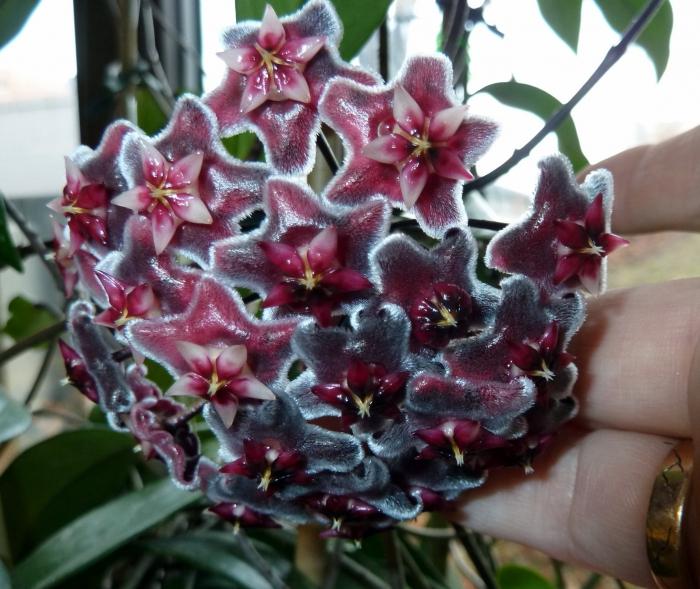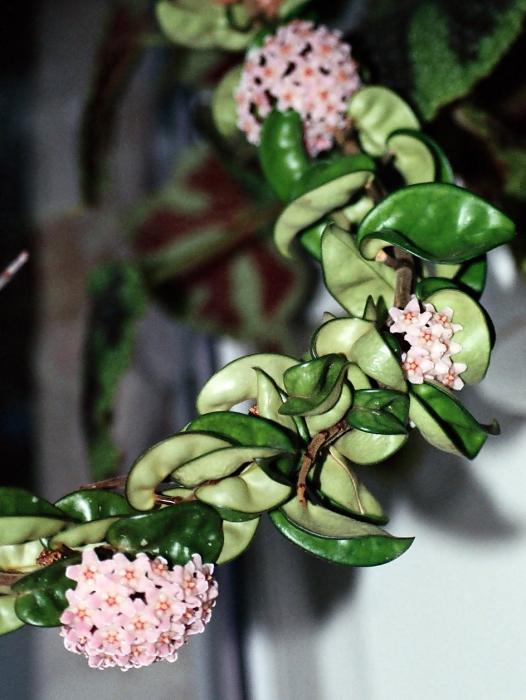Hoya came to our homes from Southeast Asia: from the south of Indonesia and China, from New Guinea, Thailand, from the islands of the Malay archipelago, some parts of India. In addition, it can be found in northern Australia. Hoya is unpretentious , home care is simple.
This unique flowering liana belongs to the Asclepiadaceae family. Hoya crosses very reluctantly. Therefore, their variety diversity is limited to about 200 varieties. The appearance of the plant is a fleshy stem, which eventually becomes stiff, surrounded by parallel-sitting leaves. Peduncles grow directly from the stem. Inflorescences consist of flowers sitting on long stalks, umbrella growing from a peduncle in an amount of 3 to 20. Their size depends on the variety and variety.

There are lianas with very large flowers of 8-10 cm (Red Imperial) and with small ones - up to 1 cm (Kerry hoya). And in Hoya Nicholson, the size of the entire inflorescence is up to 4.5 cm. For the most part, the flowers of this plant are fragrant, smooth and glossy, dissected, five-lobed. But there are varieties with pubescent flowers, for example, Kaudata, Mirabilis. Of all the stands, the hoya of Multiflora. Its complex two-tier star-shaped flowers cannot be confused with any other variety. The Campanulata hoya is not far behind her - her inflorescence, like every flower, resembles a parachute, because the bracts are fused, slightly dissected. The color of the hoya petals ranges from dark burgundy gray to white and yellow-white. One peduncle can bloom for several years, so do not remove it after flowering.
The shape and color of the leaves are also very variable. There are hoyas with small leaves up to 3 cm (Kurtisi), and giant varieties such as Lambi, which have palm leaves. Their shape can be round, oval, long, similar to a pea pod (Shepardi), a heart (Kerry), twisted (Indian rope). The color of the leaves can be even green, variegated yellow-green, green in white specks or with strokes.
Growing and Care Rules
Hoya flower is a home plant. It is not suitable for growing in the Russian garden, because it loves warmth, is afraid of the winds and the scorching sun. Under the direct sun, the leaves turn red and get powerful burns, and the wind can slow its growth. This creeper has a rather small root system, so it does not need bulky pots. A meter-long plant, and even with shoots, can easily grow in a 9-centimeter pot (volume from 0.45 to 0.5 liters). Hoya is demanding for watering, home care should include some rules. The soil for cultivation should be light, but moisture-resistant.

Liana does not tolerate overflow - she will not grow in a wet pot. It should be with enough holes to drain water. However, these are very moisture-loving plants. The following soil composition for hoya is possible: garden soil or ordinary soil should be diluted with sphagnum, vermiculite and fine expanded clay (2/1 / 0.5 / 0.5). It must be remembered that in its content it is very similar to succulent and does not like too oily soil. Therefore, if you have black soil at your dacha, then we advise you to add quite a bit of such land.
Hoya is very variable, home care depends on what type it is. If you have a plant with thick fleshy leaves - you can not allow constant overmoistening. The soil between waterings should dry completely. It will be nice if the plant stands dry for several days. For 4-5 days nothing will happen to him. But this is a good prevention of decay. Such hoyas like to soak under the slanting sunbeams. For plants with thin leaves, you can recommend more frequent watering and less sunlight. And on the north window, such a vine will grow normally. When dry, thin-leaved species may lose foliage.
Hoyas with pubescent light green leaves love the bright but not scorching sun, plentiful watering without stagnation of water. They do not like overdrying, which leads to rapid dehydration and wilting of leaves. Plants with pubescent dark green leaves prefer the usual content. These are shade-tolerant species that can be watered as the earthen coma dries out.
Hoya does not tolerate a large amount of mineral substances; home care does not provide for frequent and abundant top dressing. They need to be fed very carefully. It is best to buy fertilizer for succulents or orchids for this plant. If you have no desire to buy, but want to use what is, you can feed fertilizer for decorative leaves and for flowering (alternately). But in this case, the solution must be made 4-5 times weaker than recommended on the label.
Breeding methods
The best way to propagate hoya is vegetative using cuttings. But it is almost impossible to grow it from a leaf cutlery, because the leaf does not have cells that provide the appearance of a growth point. Therefore, even if your leaf gives roots, one percent out of a hundred that it will take root and grow. Unless you got a leaf with a piece of stem. Then grow hoya from a leaf is difficult, but possible.
For rooting, it is best to have a stalk with two pairs of leaves - then it is likely that the stalk will be accepted. It should be planted in a small pot in the same soil composition as for adult plants, described above. But the land there needs to be added even less. For faster rooting, it is better to cover the stalk with a jar or wrap the pot in a transparent bag, providing greenhouse conditions. When the stalk begins to grow, it can be planted in a permanent pot. At the same time, one must take into account the fact that in an excessively large capacity the hoya will not only not bloom, but will grow very slowly, since with a large volume of planting soil this “cunning” liana prefers to grow the root rather than the aerial part.